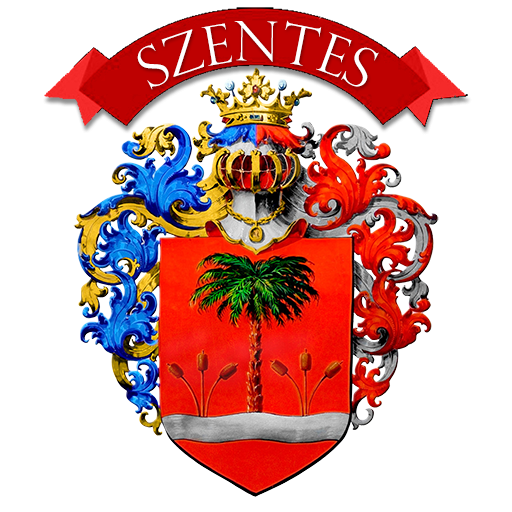Audio Guide
MP3-as turisztikai térkép nagyobb térképen való megjelenítése
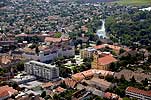 | Introduction Szentes with its 30.000 inhabitants is the third most populous settlement in Csongrád County. Situated in the South East of the Great Plain it is very lucky not only because of the high number of sunny hours, but because its richness in thermal water. Szentes is located near the Tisza, the second biggest river of Hungary. The small but youthful town receives the representatives of economy, sports, culture and tourism with a warm welcome; it is open for the other people and takes pride in showing its own values. Verzió: 2010. 06. 01. Fájl mérete: Letöltések száma: 385 |
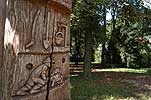 | The Széchenyi Grove and the Csallány Gábor Exhibition Place We start our trip in Széchenyi Grove, the ‘island of experience’, where, apart from thermal, experience, swimming and children pools, slides, playgrounds and tennis courts, peaceful green area is waiting for the visitors. Verzió: 2010. 06. 01. Fájl mérete: Letöltések száma: 386 |
 | Szentes Holiday resort If you want something different than the crowd of the posh holiday resorts Szentes is a perfect place to spend a few days with your family in quiet and peaceful surroundings near the waters. The open-air summer artesian swimming pool, behind the building of the Turkish bath, was completed in 1896. The swimming pool or strand, as Hungarians say, is a perfect place for passive and active holiday makers as well. Verzió: 2010. 06. 01. Fájl mérete: Letöltések száma: 415 |
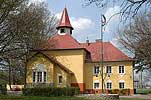 | Dózsa House and the sport fields Dózsa House was built between 1932 and 1937 in neo-romantic style, based on the plans of Antal Endre és Dobovszky József István. It was constructed by Vitéz Orgován János bricklayer from Szentes. The enormous oak standing in front of the building was planted at the time of the construction and a National Flag Pole was erected in 1942. In 2002 the building was restored with the help of the Local Government. Verzió: 2010. 06. 01. Fájl mérete: Letöltések száma: 405 |
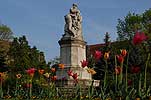 | Elisabeth Square Szentes, with its squares opening into each other, opens the hearts and connects the people. Walking over the first stone bridge of the town, from the direction of Csongrád, we arrive at the square formed in 1914 and named after Queen Elisabeth. It was originally called Holy Trinity Square because of the Holy Trinity Statue situated in the western part of the square. The square shaped, plinth of the limestone statue is on a mount (with three steps) that was newly carved around 1980. Verzió: 2010. 06. 01. Fájl mérete: Letöltések száma: 403 |
 | Saint Anne Church On the corner of St Imre Street that runs into Elisabeth Square is one of the most significant buildings of the town, the Roman Catholic St Anne Church. Apart from one tower the baroque church, built between 1764 and 1768, was demolished in 1844. The church acquired its present neo-classic form in 1847. During the build up the tower had another storey and it was completed in late neo-baroque style. The façade was fronted with circular head of windows. In the niches of the main façade the statues of St John and St Peter can be seen (1768). Verzió: 2010. 06. 01. Fájl mérete: Letöltések száma: 411 |
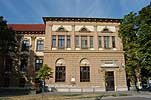 | Horváth Mihály Grammar School The eclectic styled two-storey main building of Horváth Mihály Grammar School, which has a great history, was built of brick after Benkó Károly’s design in 1888 then, between 1915 and 1918 it was enlarged with flanks after Ybl Lajos’s design. The grammar school, which has been operating since 1859, is the most tarnished secondary school in Szentes. Its high standard language training and the special drama class which was founded first in the country made the school famous. In the assembly hall there is the life-sized portrait of Zolnay Károly who was a former headmaster and the organiser of the local secondary school system. Verzió: 2010. 06. 01. Fájl mérete: Letöltések száma: 420 |
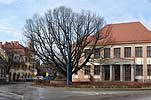 | The Olympic Oak As we walk along Szent Imre Herceg Street we arrive at the corner building of Petőfi Sándor primary School which used to be a Civil Girl School. The school was built after the plans of Bohn Alajos in 1912-13 in eclectic style. The main entrance is shaped as a tympanum with four round stone columns. In the entrance hall the school founder headmaster Papp Lajosné Gonda Júlia’s plaque can be seen that was placed by Csallány Gábor Circle of Friends of Museum in 1994. Verzió: 2010. 06. 01. Fájl mérete: Letöltések száma: 394 |
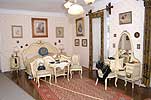 | Péter Pál Civic House Museum At the corner of Petőfi Sándor and Iskola Street is Péter Pál Civic House, built around 1830 in classicist style with columns, and is the early example of brick buildings in the Great Plain. The house that has a beautiful garden and a cellar functions as a guest house as well. Among the collection of Péter Family’s everyday objects and documents civic documents of Szentes from between 1836—1945 are displayed here. Verzió: 2010. 06. 01. Fájl mérete: Letöltések száma: 413 |
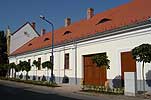 | The House of Arts The House of Arts is situated in the heart of the town next to Petőfi Hotel that was built in Hungarian art-nouveau style and it is run by Rainbow Basic Art School (Szivárvány Alapfokú Művészetoktatási Intézmény).The house was built around 1840 and until 1952 the richest citizens of the town owned it. In 1968 it was declared as a protected building. In the past decade the farthest chimney was occupied by storks that came back year after year to their nest so the people of the town call the house ‘Stork House’. Verzió: 2010. 06. 01. Fájl mérete: Letöltések száma: 387 |
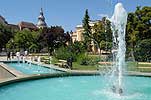 | Kossuth Square At the end of Petőfi Sándor Street we arrive at the main square of the town, which has borne the name of Kossuth Lajos since 1892. The most beautiful public buildings of Szentes are situated around the former market place. Kossuth Lajos – accompanied by Jókai Mór and Vasvári Pál – drove through the present Ady Endre Street to the old County Hall on 1st October 1848. His statue by Tóth István was placed in 1934 to the south-east part of the square where Kossuth held his speech that had a great impression on the people of the town. Verzió: 2010. 06. 01. Fájl mérete: Letöltések száma: 403 |
 | The Town Hall The southern side of the Kossuth square is dominated by the Town Hall with its mansard roofed façade and a corner turret. The Town hall was built in 1911 according to the plans of Bohn Alajos architect who was born in Arad. (Dr. Mátéffy Ferenc mayor was the head of the building committee). The most important construction works were made by trades people of Szentes. The building that was built in neo-baroque style is lining Kossuth and Elisabeth Square with its two mansard roofed facades and it is joined by a 37 meter high round corner turret that includes the main entrance with oval windows and columns. Verzió: 2010. 06. 01. Fájl mérete: Letöltések száma: 494 |
 | Koszta József Museum The main building of the western part of Kossuth Square is the commanding neo-renaissance building of the former County Hall. Today it functions as a conference centre and home of the Archives and Koszta József Museum. The documents which contain information on Csongrád County, Szentes town and the old districts from the 18th century hitherto are preserved in the Archives and there is also a great collection of maps, posters and photographs. Verzió: 2010. 06. 01. Fájl mérete: Letöltések száma: 397 |
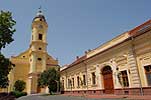 | The Great Calvinist Church The northern side of the Kossuth Square is dominated by the beautiful early neo-classic Calvinist Church. The lower part of the tower - built in 1774 - has a round balcony that was used for fire observation. The church is one of the biggest in Hungary, it has the longest nave in the Great Plain and it is the town’s biggest building with its 3500 people holding capacity. Verzió: 2010. 06. 01. Fájl mérete: Letöltések száma: 387 |
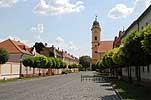 | Kiss Bálint Street Kiss Bálint Street – former Templom köz (Church Alley) – -starts behind the Calvinist Church. Many of its buildings are preserved (Nr.1-12.). The name comes from Kiss Bálint pastor of the Reformed Church, Renaissance man of his age, excellent naturalist. Number 2 is the classical, one-storied, villa-like Calvinist Vicarage with a veranda and high roof. This was the shelter of Vörösmarty Mihály (the great Hungarian poet) during the absolutism. After the reconstruction of the former Calvinist Apartment House it functions today as the Old People’s Home of the Reformed Church. Verzió: 2010. 06. 01. Fájl mérete: Letöltések száma: 388 |
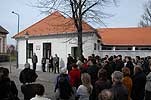 | Tóth József and Sima Ferenc Street When we turn back to Elisabeth Square and walk north towards Tóth József Street, we can find the house, next to Kiss Bálint Calvinist Primary School, where Boros Sámuel the first Mayor of the town lived. The house is more than 200 years old and it used to be the home of the all-time judge of the town until it was given to the Mayor. On his recruiting tour Kossuth Lajos spent a night here in the 1st of October 1848. Verzió: 2010. 06. 01. Fájl mérete: Letöltések száma: 387 |
 | St Nicholas Church Now we return to Kossuth Street and have a look at the sights of the main street. Right behind the six-storey building is the oldest historic relic of the town the St Nicholas Greek Orthodox Church. Because of the warlike circumstances in the first part of the 18th century several Greek trader families immigrated to Hungary and many of them settled down in Szentes. First they practised their original, orthodox religion secretly at private houses. In 1773 there were only 16 Greek inhabitants of the town but 10 years later their number grew to 114. Verzió: 2010. 06. 01. Fájl mérete: Letöltések száma: 387 |
 | Fridrich Studio Atelier This photographic studio is part of the Koszta József Museum with its special collection of photos at St Nicolas Square. The studio that was built in 1905 and restored in 1997 is the only one Studio Atelier of the countryside. On the wall of the building is the plaque of Rózsa Gábor local patriot engineer-museologist. Inside the building the photos of Fridrich János are exhibited together with his photographic equipments. Fridrich János photographer took excellent genre-and group photos in his sunny photographic studio before the time of electric lights. Verzió: 2010. 06. 01. Fájl mérete: Letöltések száma: 387 |
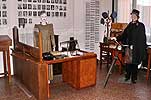 | Memorial room of the Southern Region’s Post Office History In the building of the post office of the main street is the Memorial Room of the Southern Region’s Post Office History. The exhibition was founded in 2003 by some postmen as a result of many decades’ collection work. Active and retired workers of the Southern Region continuously enrich the collection. In January 2009 2799 types of object (3928 pieces), documents and printed papers were displayed in 5 rooms. Verzió: 2010. 06. 01. Fájl mérete: Letöltések száma: 384 |
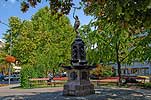 | Evangelical Church of Luther Square Walking along Kossuth Square we arrive at Luther Square where the neo-gothic, brick Evangelical Church stands, based on the plans of Francsek Imre, 1905. The town gave the illuminating clock face of the spire to the church as a present. The presentation ceremony was made by Bachát Dániel bishop. The windows are made of colourful glass mosaic, forming the scenes of Christ‘s life in the altar area. The slim steeple, the long, narrow lancet windows, emphasised buttresses, steep roofing, small spires and the rose window above the entrance are all referring to the most typical architectural elements of the gothic style making this church the clearest example of its style in the area. Verzió: 2010. 06. 01. Fájl mérete: Letöltések száma: 377 |
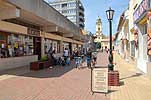 | Nagy Ferenc Street With a little by-pass, we visit the town’s pedestrians only Nagy Ferenc Street, which received its present restored form in 2006. From here we can immediately see the cinema of the town. The building of Őze Lajos Movie Theatre can house 300 viewers. The movie theatre was named after Őze Lajos the famous actor who was born in Szentes. Verzió: 2010. 06. 01. Fájl mérete: Letöltések száma: 411 |
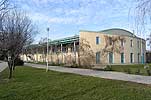 | Sports Hall Walking along Nagy Ferenc Street we arrive at Dr Papp László Sports Hall, which is the most important place of the town’s sports life. Because of its great facilities this is the house of town’s great events for example the popular Winter Farewell Carnival, Hungarian and European Championships, sport festivals and other local events throughout the year. The townspeople lead a very active life and in 1996 the ‘National Sports Town’ title was awarded to Szentes. Verzió: 2010. 06. 01. Fájl mérete: Letöltések száma: 385 |
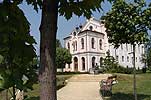 | The Synagogue The Synagogue that was restored in 1998 is in the main street of Szentes and it is the home of the Town Library. It was built in Romantique style based on the plans of Knabe Ignác, and after 40 years of neglect it became one of the most beautiful buildings of the town. The garden of the library, maintained by trickle irrigation, is the home of more and more works of art. The library consists of 115.000 books, 187 different types of magazines with news and up-to-date information. Other services available here: internet connection, photocopy, fax, computer text editing and CD law collection. Verzió: 2010. 06. 01. Fájl mérete: Letöltések száma: 415 |
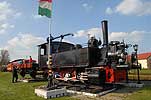 | Railway History Exhibition First Kossuth Street then its continuation Baross street leads us to the Railwaystation. The first railway of the town was built in 1887 between Szentes and Kunszentmárton and the railway station, which soon became small due to the growing number of passengers. The new building was completed between 1928 and 29 in Hungarian Art Nouveau style based on the plans of Magyary Zoltán. It was restored in the middle of the 1980’s; its style and ornaments were kept. Verzió: 2010. 06. 01. Fájl mérete: Letöltések száma: 417 |
